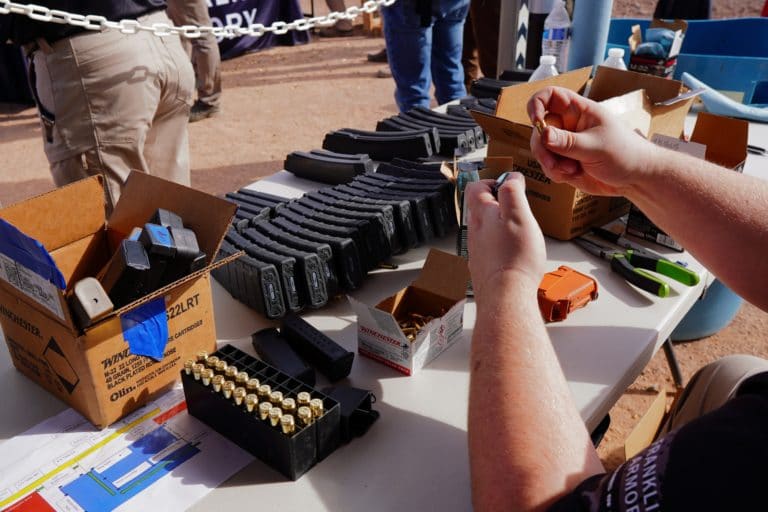Gun-control advocates secured a big win when Oregon’s Measure 114 passed. But it could become a major headache for them before all is said and done.
The Associated Press officially called the race in favor of Measure 114 earlier this week. By a slim 1.6 percent margin, Oregonians voted in a new permit-to-purchase requirement for all gun sales and a ban on ammunition magazines capable of holding more than ten rounds.
To receive a permit, a resident must apply with their local sheriff or police department, pay a $65 fee, pay for and complete an approved firearms training course, submit a photo ID, be fingerprinted, and pass a state-run criminal background check in addition to the federal background check required on gun sales by licensed dealers. The measure directs Oregon State Police to create and maintain a database of all permit-to-purchase applicant information, which opponents of the law have charged would function as a de facto gun registry.
Additionally, residents who currently own magazines capable of holding more than ten rounds–many of which come standard with commonly-owned handguns and rifles–would only be allowed to use them at shooting ranges and on private land.
It institutes some of the strictest gun laws in the country by direct vote, even if by less than most might expect in a deep blue state. That’s still a significant win for gun-control advocates.
But getting the measure passed was only the first step. The implementation might show the juice wasn’t worth the squeeze.
While the measure mandates systems and databases for processing purchase permits, local law enforcement agencies have been left with little time, funding, or guidance on how exactly to create and manage such systems.
The measure did not earmark any money to fund the databases or staffing needed to process the background checks or operate the permitting service. State law enforcement officials have said the $65 fee built into the measure would be insufficient to fund those efforts.
Adding to the disorder is the fact that the measure’s backers were misguided about when the law would actually take effect. Operating under the assumption that it would take effect on January 15 of next year, the backers assumed state agencies had plenty of time to build out the required processes of the law (something even then many sheriffs disputed).
However, the Secretary of State’s office has since clarified (and the Oregon State Police has confirmed to The Reload) that the law will actually take effect on December 8, more than a month sooner than anticipated. The measure’s backers sought to have Governor Kate Brown (D.) delay its implementation date, but the Governor’s office declared that she did not have to power to do so.
That means the state’s law enforcement agencies, already understaffed, underfunded, and ill-prepared to handle the measure’s new mandates, will have to figure it out on an expedited timeline. The Oregon State Sherriff’s Association is already warning residents that the law will be impossible to implement on the mandated timeline, likely resulting in a complete halting of gun sales across the state after December 8.
“As of the date the measure goes into effect we believe that all firearms sales by dealers, at gun shows and most private transfers (other than to a close relative) in Oregon will immediately stop,” the group said in a statement. “The revenue generated by the permits ($65 for each permit) will not come close to fully funding the required processes. In most law enforcement agencies there is no personnel or money to fund this required program.”
Gun-rights groups are already chomping at the bit to file a lawsuit against Measure 114. When they do, and if the predicted moratorium on all legal gun sales comes to pass, securing emergency injunctive relief in court should be a slam-dunk. Oregon will then have to demonstrate that a requirement for purchase permits and a ban on commonly-owned magazines is consistent with the nation’s history and tradition of gun regulation, as the Supreme Court established in NYSRPA v Bruen. That will certainly be a tall order.
The ensuing legal battle over the measure seems particularly poised to catch the attention of the Supreme Court. Multiple federal courts across the country are already evaluating the legality of magazine bans in light of Bruen, including two cases out of California and New Jersey upholding bans that the Court specifically said should be revisited. After evaluating the legality of requiring permits to carry a gun in public as the Court did in Bruen, examining the legality of requiring permits for gun ownership is a natural next step for the Court to take.
In the meantime, the only other practical effect of Measure 114’s passage is sparking a return to record-level gun sales in the Beaver state. Since November eighth, the Oregon State Police have reported a massive 382% increase in firearm background checks. They’ve averaged over 4,000 checks per day.
Much will ultimately depend on how the courts decide to apply Bruen to Measure 114 and the mess that’s currently unfolding in Oregon. But when all is said and done, there’s a distinct possibility that all it will have accomplished is a brief boost in gun sales and a new court precedent favorable to gun-rights advocates.







2 Responses
It seems as though the big question at hand, is Oregon in the 9th Circuit?
It is.